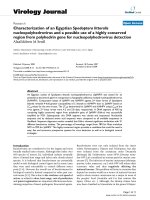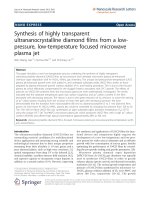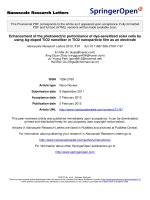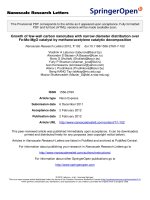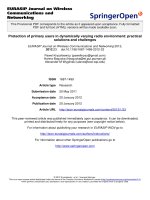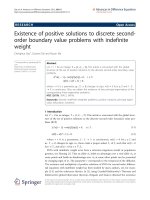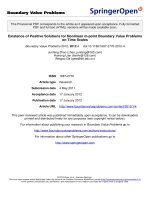Báo cáo toán học: " Synthesis of highly transparent ultrananocrystalline diamond films from a lowpressure, low-temperature focused microwave plasma jet" ppt
Bạn đang xem bản rút gọn của tài liệu. Xem và tải ngay bản đầy đủ của tài liệu tại đây (3.13 MB, 8 trang )
NANO EXPRESS Open Access
Synthesis of highly transparent
ultrananocrystalline diamond films from a low-
pressure, low-temperature focused microwave
plasma jet
Wen-Hsiang Liao
1,2
, Da-Hua Wei
1,2*
and Chii-Ruey Lin
1,2*
Abstract
This paper describes a new low-temperature process underlying the synthesis of highly transparent
ultrananocrystalline diamond [UNCD] films by low-pressure and unheated microwave plasma jet-enhanced
chemical vapor deposition with Ar-1%CH
4
-10%H
2
gas chemistry. The unique low-pressure/low-temperature [LPLT]
plasma jet-enhanced growth even with added H
2
and unheated substrates yields UNCD films similar to those
prepared by plasma-enhanced growth without addition of H
2
and heating procedure. This is due to the focused
plasma jet which effectively compensated for the sluggish kinetics associated with LPLT growth. The effects of
pressure on UNCD film synthesis from the microwave plasma jet were systematically investigated. The results
indicated that the substrate temperature, grain size, surface roughness, and sp
3
carbon content in the films
decreased with decreasing pressure. The reason is due to the great reduction of H
a
emission to lower the etching
of sp
2
carbon phase, resulting from the increase of mean free path with decreasing pressure. We have
demonstrated that the transition from nanocrystalline (80 nm) to ultrananocrystalline (3 to 5 nm) diamond films
grown via microwave Ar-1%CH
4
-10%H
2
plasma jets could be controlled by changing the pressure from 100 to 30
Torr. The 250-nm-thick UNCD film was synthesized on glass substrates (glass transition temperature [T
g
] 557°C)
using the unique LPLT (30 Torr/460°C) microwave plasma jet, which produced UNCD films with a high sp
3
carbon
content (95.65%) and offered high optical transmittance (approximately 86% at 700 nm).
Keywords: ultrananocrystalline diamond films, focused microwave plasma jet, low-pressure/low-temperature synth-
esis, transmittance
Introduction
The ultrananocrystall ine diamond [UNCD] films are
outstanding material candidates for multifunctional
device applications and attrac ting s trong scientific and
technological interests due to their unique properties
stemming from their u ltrafine (< 10 nm) grains and a
pure diamond phase, such as high wear resistance [1],
opt ical transparency from deep UV to far infrared [2,3],
chemical stability , excellent electron field emission [4,5],
and superior capacity to incorporate n-type dopants in
addition to a smooth surface [6-9]. However, improving
the syntheses and applications of UNCD films for func-
tional devices and components highly requires the
developmen t of a new lo w-tempe rature and low-pres-
sure process for wider uses in substrates and an effective
growth with low consumption of source gases, besides
optimizing the perfor mance o f UNCD films by control-
ling the pre-growth seeding and growth parameters [10].
Microwave plasma chemical vapor deposition
[MPCVD] from Ar-1%CH
4
gas chemistry was typically
used to synthesize UNCD films in order to greatly
enhance plasma species activity and diamond secondary
nucleat ion [10-12]. The normal growth temperature and
pressure of UNCD f ilms synthesized by mi crowave Ar-
1%CH
4
plasma witho ut addition of H
2
were 800°C and
above 100 Torr, respectively [10-12]. The growth
* Correspondence: ;
1
Department of Mechanical Engineering and Institute of Manufacturing
Technology, National Taipei University of Technology, Taipei, 106, Taiwan
Full list of author information is available at the end of the article
Liao et al. Nanoscale Research Letters 2012, 7:82
/>© 2012 Liao et al; licensee Springer. This is an Open Access article distributed under the terms of the Creative Common s Attribution
License ( which permits unrestricted use, distribution, and reproduction in any medium,
provided the original work is properly cite d.
temperature depended on the substrate and plasma
heating during synthesis. Commonly, the plasma heating
cannot be avoided during UNCD growth; thus, minimiz-
ing the plasma heating is crucial to realize a low-tem-
perature synthesis. Therefore, argon-rich (hydrogen-
poor) microwave plasma is popularly adopted for low-
temperature preparation of UNCD films due to the
much lower thermal conductivity of argon and much
less power levels required for argon plasma formation
compared with hydrogen [10].
The microwave plasma jet-enhanced chemical vapor
deposition [ MPJCVD] for UNCD film synthesis devel-
oped in our lab takes several advant ages compared with
the regular MPCVD process, nam ely which can improve
the density and activity of plasma species through exci-
tation of the focused plasma jet [ 13,14], enabling it to
achieve high-efficiency and high-quality deposition at
low-pressure/low-temperature [LPLT] conditio ns (with-
out substrate heating). The MPJCVD-enhanced growth
[MEG] is particularly critical in LP LT deposition to
compensate for the insufficient density and kinetics of
growth species associated with LPLT synthesis. There-
fore, we describe here a unique plasma jet technique to
successfully grow UNCD films at LPLT (30 Torr/460°C)
that yields films with smooth surface, pure diamond
nanograins (3 to 8 nm), and high optical transmittance
in the visible light region using relatively low pressure,
low power (700 W), and even with addition of H
2
(Ar-
1%CH
4
-10%H
2
) compared with the typical plasma pro-
cesses [10-12]. The highly transparent UNCD films were
grown directly on glass subst rates with a low glass tran-
sition temperature (T
g
557°C). The process opens
further feasibility for the LPLT synthesis o f UNCD
films, providing a promising platform fabrication for dia-
mond-based multifunctional devices and coating on low-
melting point materials with low cost. The synthesis and
characteristics of UNCD films produced by the MEG
technique at various growth pressures (5 to 100 Torr)
and temperatures (400°C to 700°C) were systematically
studied by in situ optical emission spectroscopy [OES],
visible Raman spectroscopy, synchrotron-based X-ray
absorption near-edge structure [XANES] spectroscopy,
atomic force microscopy [AFM], field-emission scanning
electron microscopy [FESEM], and field-emission trans-
mission electron microscopy [FETEM].
Experimental details
The diamond films were synthesi zed using the ho me-
made MPJCVD syst em. The plasma jet was indu ced in
Ar-1%CH
4
-10%H
2
gas chemistry at a microwave power
of 700 W. The total pressure of reactant gas was varied
from 5 to 100 Torr (5, 15, 30, 60, 80, and 100 Torr) in
the synthesis o f diamond films. The deposition process
was carried out without heating the substrates. The
substrate temperature was influenced only by plasma jet
heating at various pressures from 5 to 100 Torr, which
increased from approximately 400°C to 700°C with
increasing pressure. The growth rate o f t he diamond
films using plasma jet was gradually increased with
increasing pressure, approximately 0.25 μm/h at 30 Torr
and approximately 0.97 μm/h at 100 Torr. The thick-
ness of the diamond films was confirmed by a FESEM
image of the cross section. N-type Si wafers with a (100)
orientation we re initially used as substrat es for the
deposition of diam ond films at various pres sures. The
glasssubstrateswithT
g
of 557°C were applied to sup-
port LPLT UNCD films for the fabrication of highly
transparent coatings and further confi rmed the success-
ful synthesis of UNCD films at a LPLT condition with-
out any damage to the subs trates. Pretreatment on the
substrates was performed by the spin coating of a dia-
mond nanoparticle solution to enhance nucleation at
low temperature [13].
The as-grown films were characterized by FESEM (S-
4800, Hitachi, Chiyoda-ku, Tokyo, Japan), visible Raman
spectroscopy (micro-Raman, Renishaw Inc, Taichung,
Taiwan), synchrotron-based XANES spectroscopy (Car-
bon K-edge spectra with a r esolution of 0.1 eV, total
electron yield mold, a t the Dragon BL11 A beamline of
the National Synchrotron Radiation Research Center in
Taiwan), FETEM (Tecnai F30, Philips, Best, The Nether-
lands), and AFM (NS3a, Digital Instruments, Santa Bar-
bara, CA, USA) for obtaining comprehensive
information on the surface morphology, roughness,
atomic bonding nature, and detailed nanostructural
characterizations. Optical transmission spectrum of the
as-grown UNCD films ranging from 350 to 950 nm was
characterized with a UV-A/Visible/near-IR spectrophot-
ometer (MP100-M, Mission Peak Optics, Fremont, CA,
USA). The focused microwave plasma jet was analyzed
during synthesis by in situ OES (BTC112E, B&W TEK,
Newark, D E, USA) to explore the species composition
at different growth processes.
Results and discussion
Plan-view SEM micrographs sho wn in Figure 1 demon-
strated an obvious change in the surface morphology of
as-grown films while pressures are increased from 5 to
100 Torr in the MEG process. The apparently discontin-
uous film shown in Figure 1a indicated that the least
effective deposition was at the pressure of 5 Torr. The
film deposited at 15 To rr still has few remaining vacant
sites but almost fully covered the Si substrate a s shown
in Figure 1b. For the deposition at a pressure of 30 Torr
(Figure 1c), a uniform and smooth film composed of
very fine grains was obtained without any visible pin-
holes. This condition is employed to estimate a mini-
mum demand for gro wth pressure to o btain a dense
Liao et al. Nanoscale Research Letters 2012, 7:82
/>Page 2 of 8
and continuous film from the focused microwave
plasma jet. A further increase in pressure induced the
diamond film’s surface to form an elongated cluster
with a needle-like structure of about 300 nm in length,
as shown in F igure 1d, e. Figure 1f shows that the film
grown at 100 Torr would form distinctly greater clusters
and a rougher surfac e morphology c ompared to nearly
invisible boundaries at a growth pressure of 30 Torr
Figure 1 SEM images of the diamond films grown by microwave Ar-1%CH
4
-10%H
2
plasma jet at various pressures.(a)5,(b)15,(c) 30,
(d) 60, (e) 80, and (f) 100 Torr.
Liao et al. Nanoscale Research Letters 2012, 7:82
/>Page 3 of 8
(Figure 1c). With the increase in growth pressure, the
grain size of the diamond films seems to gradually
increase with increasing c luster size and surface rough-
ness. However, the exact size of the nanocrystallites can-
not be clearly identified by SEM due to the limited
resolution, and the details were further e xplored and
discussed below.
Figure 2 shows the visible (wavel ength 514.5 nm)
Raman spectra of the diamond films grown by the
MEG process at various pressures from 15 to 100
Torr. Raman spectra of as-grown films typically reveal
nanocrystalline diamond [NCD] features [10,15]. The
peak of the sp
3
-bonded carbon (diamond) around 1,
332 cm
-1
has disappeared or is overlapped by the D
(disordered) band of the sp
2
-bonded carbon (non-dia-
mond) around 1, 350 cm
-1
while the films were grown
at 15, 30, and 60 Torr. The reason is due to the dia-
mond films consisted of nanocrystallites with a higher
proportion of grain boundaries [GBs] which enhanced
the much higher sensitivity of sp
2
bonding over sp
3
bonding by visible Raman [10,16,17]. The sharp peak
intensity of the sp
3
-bonded carbon is increased in
spectra of the films grown at relatively high pressure
(80 and 100 Torr), indicating that the quality of the
diamond films was gradually improved as the pressure
increased. Simultaneously, the decrease and broadening
of the G (graphitic) band at 1, 5 60 cm
-1
with increas-
ing p ressure demonstrate the sp
2
fraction reduction in
the films, also implying that the grain size was
increased due to the decrease of the GBs proportion
[14,18]. This is in accord with the observation in the
SEM images (Figure 1).
Figure 2 Visible Raman spectra of diamond films grown by microwave Ar-1%CH
4
-10%H
2
plasma jet at various pressures.
Liao et al. Nanoscale Research Letters 2012, 7:82
/>Page 4 of 8
Two trans-polyacetylene [t-PA] bands were observed in
the spectra at approximately 1, 140 and 1, 480 cm
-1
while
the films were grown at a bove 60 Torr, which repre-
sented the NCD structures that existed at the GBs in the
films [15,19,20]. Interestingly, t he spectra were found to
show a peak centered at approximately 1, 190 cm
-1
as the
synthesis w as at a pressure f rom 15 to 80 Torr. The
decrease in this peak with increasing pressure is opposite
to the t-PA bands in the spectra. This phenomenon likely
originated from the difference in the crystal size between
UNCD and NCD films. Moreover, the concurrent
absence or weakening of the peaks located at 1, 190 and
1, 140 cm
-1
(t-PA) for the sample grown at 100 Torr sug-
gested that the content of C-H bonds (t-PA) in the films
would be decreased with increasing pressure (5 to 100
Torr) and temperature (400°C to 700°C). A decrease in
the relative GB fraction for t-PA bands existed, and the
increase in t he substrate t emperature was to promote
hydrogen desorption from the films [10,18]. The decrease
of hydrogen trapping during synthesis i s expectably
caused by high-temperature growth (high-pressure) due
to the hydrogen desorption temperature which is
between 600°C and 1, 000°C [21]. The above features of
visible Raman spectra are similar to those of the UNCD
films deposited by microwave Ar-1%CH
4
plasma at var-
ious substrate heating [ 10], but the bonding structure
and quality of the fil ms are controlled by pressure via the
MEG process, suggesting that the MEG process could
improve the synthesis of the UNCD films at LPLT with-
out substrate heating.
Figure 3a shows the plan-view TEM image of the dia-
mond film grown at 100 Torr, which reveals distinctly
Figure 3 TEM images and XANES spectrum. Plan-view TEM image of the diamond film grown by the microwave Ar-1%CH
4
-10%H
2
plasma jet
at (a) 100 and (b) 30 Torr. (c) Enlarged TEM image of (b); the inset shows the corresponding NBD pattern of a single diamond nanograin. (d)
The XANES spectrum of the UNCD film grown from the LPLT (30 Torr/460°C) plasma jet technique.
Liao et al. Nanoscale Research Letters 2012, 7:82
/>Page 5 of 8
that the grain size is approximately 80 nm with a round-
ish geometry. The plan-view TEM image shown in Fig-
ure 3b illustrated that the diamond film grown at 30
Torr consisted of ultran anosized (3 to 8 nm) crystal lites
(UNCD) uniformly dispersed in an amorphous carbon
matrix. Figure 3c shows the enlarged TEM imag e of the
MEGUNCDfilmsgrownat30Torr,andtheinset
shows the corresponding nanobeam diffraction [NBD]
pattern of a single diamond nanog rain (approximately 5
nm) with a spherical shape. The beam diameter used for
NBD was approximately 15 nm, allowing for the diffrac-
tion pattern from only one or a few diamond nanograins
to be observed. The diffraction pattern shows discs of
intensity for the {111} planes of diamond, indicating that
a single nanograin is a s ingle crystalline diamond [22].
To definitely dist inguish betw een the sp
2
and sp
3
bonds
in hybridized carbon materials, C K-edge XANES spec-
trum has been applied as shown in Figure 3d. Figure 3d
clearly indicates that a typical fine structure for MEG
UNCD films (30 Torr/460°C) is a cubic diamond (C 1s
core exciton at approximately 289.7 eV and C-C 1s ®
s* hybrid bonds between approximately 290 and 302
eV) o f 95.65% with a small fraction of the sp
2
-bonded
carbon(C=C1s ® π* at approximately 285.3 eV) and
C-H bonding (C-H 1s ® s* at approximately 287.5 eV)
at GBs [23,24]. The TEM analyses confirmed th at the
grain size of the diamond films decreased (from 80 nm
to 3 to 8 nm) with decreasing pressu re (100 to 30 Torr)
and consisted with the previous SEM (Figure 1) and
Raman analyses (Figure 2). The TEM and XANES ana-
lyses also further confirmed that UNCD films could be
successfully synthesized at LPLT by a microwave Ar-1%
CH
4
-10%H
2
plasma jet without substrate heating, which
is identical to grain size distribution and atomic bonding
characteristics of the UNCD films grown by a micro-
wave Ar-1%CH
4
plasma with substrate heating.
The in situ OES spectra (Figur e 4) were performed to
diagnose the species composition in the Ar-1%CH
4
-10%
H
2
plas ma jets in order to understand the growth beha-
vior resulting from the increase in growth pressure and
temperature to lead to such changes on structural and
bonding characteristics of diamond films. OES spectra
Figure 4 In-situ OES spectra of diamond films grown by microwave Ar-1%CH
4
-10%H
2
plasma jet at various pressures.
Liao et al. Nanoscale Research Letters 2012, 7:82
/>Page 6 of 8
reveal that an excited intensity of H
a
(656.2 nm) species
is increased markedly with increasing pressure and
dominant in the plasma jets with a pressure over 80
Torr. However, the decrease in Ar emissions (over 700
nm) with increasing pressure is contrary to the H
a
emis-
sion in the spectra. The high hydrogen atom concentra-
tion during synthesis could promote the etching of sp
2
carbon phase and reduce the diamond renucleation [25].
Thus, the grain size and sp
3
bonds in the diamond films
would be increased at relatively high pressure, resulting
in the NCD films (80 nm) synthesized at 100 Torr with
a rough er surface (Figure 5c). Moreover, the increase in
the m ean f ree path of plasma species with decreasing
pressure led to a greatly decreased amount of atomic
hydrogen emission (hydrogen-poor) during synthesis
and evidently, the creation of a low-temperature envir-
onment for UNCD films growth from low-pressure
MEG process with addition of H
2
[10].
The transmittance spectrum of the UNCD film with a
thickness around 250 nm grown from the LPLT MEG pro-
cess on the glass substrate w as measured in the range of
350 to 950 nm (Figure 5a). The scheme of the measure-
ment is illustrated in the bottom left inset of Figure 5. The
optical transmittance of the as-grown UNCD film is oscil-
lated due to the interference effect during the photon trans-
mission in the film, resulting in the variation of
transmittance from 60% at 450 nm to 86% at 700 nm. The
transmittance of the diamond films is dominated by the
surface smoothness and diamond (sp
3
bonding) content in
the films [26]. The film grown at 30 Torr/460°C consisted
of pure diamond nanocrystallites (3 to 8 nm) without any
thermal damage to the substrate, which retained a high
degree of diamond purity (95.65%) but revealed a far
smoother surface (12.8 nm root-mean-square [rms]) to
minimize light scattering from the surface of the diamond
films (Figure 5b), resulting in the outstanding optical trans-
parency obtained from the LPLT synthesis. The transmis-
sion analysis complemented the SEM, TEM, AFM,
XANES, visible Raman, and OES analyses to con stitute
convincing evidence of successful fabrication of highly
transparent UNCD films at LPLT condition and completed
investigation of the relationships between the growth con-
ditions, nanostructures, and material properties of the dia-
mond films synthesized from the focused microwave
Ar-1%CH
4
-10%H
2
plasma jet at different growth processes.
Conclusions
A no-heating LPLT MEG technique has been developed
successfully to synthesize UNCD films on glass sub-
strates with high transparency (approximately 86% at
700 nm), smooth surface (approximately 12.8 nm rms),
uniform diamond nanocrystallites (3 to 8 nm), and very
high sp
3
content (95.65%) using relatively low-output
power (700 W), low Ar gas chemistry (Ar-1%CH
4
-10%
Figure 5 Optical transmittance spectrum and AFM images.(a) Optical transmittance spect rum of the UNCD films grown by the LPLT (30
Torr/460°C) MEG process with a thickness of approximately 250 nm. (b) The corresponding AFM image of MEG UNCD films. (c) AFM image of
diamond films grown at 100 Torr.
Liao et al. Nanoscale Research Letters 2012, 7:82
/>Page 7 of 8
H
2
), low pressure (30 Torr), and even low temperature
(460°C) compared with the typical microwave Ar-1%
CH
4
plasma with heating procedures. The synthesis of
UNCD films using the u niquely focused plasma je t was
confirmed to efficiently compensateforthesluggish
kinetics and insufficient density of plasma species during
the LPLT synthesis. A new and effective way to control
the crystal size, surface morphology, and growth
mechanism of diamond films by regulating the growth
pressure in a systematic study was report ed. Based on
the TEM images of all films, it ha s been demonstrated
that the transition o f g rain size from NCD (80 nm) to
UNCD (3 to 8 nm) films controlled by the pressure ran-
ged from 100 to 30 Torr. The reason is due to the
increase of the mean free path for t he excitation of
plasma with decreasing pressure, resulting in a
decreased amount of atomic hydrogen emission to
greatly lower the etching of the sp
2
carbon phase during
synthesis. The NBD and XANES characterizations
further demonstrated the ultrananocrystalline diamond
nature of the films grown from the focused microwave
Ar-1%CH
4
-10%H
2
plasma jet at LPLT condition.
Acknowledgements
The authors would like to thank Dr. Chung-Li Dong and Dr. Chi-Liang Chen
for the XANES investigations at the Dragon BL11A beamline of the National
Synchrotron Radiation Research Center (NSRRC). This work was financially
supported by the main research projects of the National Science Council of
the Republic of China under grant numbers NSC 100-2221-E-027-047 and
NSC 100-2221-E-027-015.
Author details
1
Department of Mechanical Engineering and Institute of Manufacturing
Technology, National Taipei University of Technology, Taipei, 106, Taiwan
2
Graduate Institute of Mechanical and Electrical Engineering, National Taipei
University of Technology, Taipei 106, Taiwan
Authors’ contributions
W-HL and D-HW conceived and designed the experiments, analyzed the
results, and contributed to the writing of the manuscript. C-RL, together
with the other authors, revised and approved the final manuscript.
Competing interests
The authors declare that they have no competing interests.
Received: 25 August 2011 Accepted: 19 January 2012
Published: 19 January 2012
References
1. Kim K-H, Moldovan N, Ke C, Espinosa HD, Xiao X, Carlisle JA, Auciello O:
Novel ultrananocrystalline diamond probes for high-resolution low-wear
nanolithographic techniques. Small 2005, 1:866-874.
2. Kriele A, Williams OA, Wolfer M, Brink D, Müller-Sebert W, Nebel CE:
Tuneable optical lenses from diamond thin films. Appl Phys Lett 2009,
95:031905-1-031905-3.
3. Joseph PT, Tai NH, Chen YC, Cheng HF, Lin IN: Transparent
ultrananocrystalline diamond films on quartz substrate. Diamond Relat
Mater 2008, 17:476-480.
4. Zhu W, Kochanski GP, Jin S: Low-field electron emission from undoped
nanostructured diamond. Science 1998, 282:1471-1473.
5. Garguilo JM, Koeck FAM, Nemanich RJ, Xiao XC, Carlisle JA, Auciello O:
Thermionic field emission from nanocrystalline diamond-coated silicon
tip arrays. Phys Rev B 2005, 72:165404-1-165404-6.
6. Bhattacharyya S, Auciello O, Birrell J, Carlisle JA, Curtiss LA, Goyette AN,
Gruen DM, Krauss AR, Schlueter J, Sumant A, Zapol P: Synthesis and
characterization of highly-conducting nitrogen-doped
ultrananocrystalline diamond films. Appl Phys Lett 2001, 79:1441-1443.
7. Williams OA, Curat S, Gerbi JE, Gruen DM, Jackman RB: n-Type conductivity
in ultrananocrystalline diamond films. Appl Phys Lett 2004, 85:1680-1682.
8. Zapol P, Sternberg M, Curtis LA, Frauenheim T, Gruen DM: Tight-binding
molecular dynamics simulation of impurities in ultrananocrystalline
diamond grain boundaries. Phys Rev B 2002, 65:0454031-4540311.
9. Zhou D, McCauley TG, Qin LC, Krauss AR, Gruen DM: Synthesis of
nanocrystalline diamond thin films from an Ar-CH4 microwave plasma. J
Appl Phys 1998, 83:540-543.
10. Xiao X, Birrell J, Gerbi JE, Auciello O, Carlisle JA: Low temperature growth
of ultrananocrystalline diamond. J Appl Phys 2004, 96:2232-2239.
11. Zhou D, Gruen DM, Qin LC, McCauley TG, Krauss AR: Control of diamond
film microstructure by Ar additions to CH4/H2 microwave plasmas. J
Appl Phys 1998, 84:1981-1989.
12. Sumant AV, Grierson DS, Gerbi JE, Carlisle JA, Auciello O, Carpick RW:
Surface chemistry and bonding configuration of ultrananocrystalline
diamond surfaces and their effects on nanotribological properties. Phys
Rev B 2007, 76:235429-1-235429-11.
13. Lin CR, Liao WH, Wei DH, Tsai JS, Chang CK, Fang WC: Formation of
ultrananocrystalline diamond films with nitrogen addition. Diamond Relat
Mater 2011, 20:380-384.
14. Lin CR, Liao WH, Wei DH, Chang CK, Fang WC, Chen CL, Dong CL, Chen JL,
Guo JH: Improvement on the synthesis technique of ultrananocrystalline
diamond films by using microwave plasma jet chemical vapor
deposition. J Cryst Growth 2011, 326
:212-217.
15. Veres M, Tóth S, Koós M: Grain boundary fine structure of
ultrananocrystalline diamond thin films measured by Raman scattering.
Appl Phys Lett 2007, 91:031913-1-031913-3.
16. Wang CS, Chen HC, Shih WC, Cheng HF, Lin IN: Effect of H2/Ar plasma on
growth behavior of ultra-nanocrystalline diamond films: the TEM study.
Diamond Relat Mater 2010, 19:138-142.
17. Yang Q, Yang S, Li YS, Lu X, Hirose A: NEXAFS characterization of
nanocrystalline diamond thin films synthesized with high methane
concentrations. Diamond Relat Mater 2007, 16:730-734.
18. Xiao X, Wang J, Liu C, Carlisle JA, Mech B, Greenberg R, Guven D, Freda R,
Humayun MS, Weiland J, Auciello O: In vitro and in vivo evaluation of
ultrananocrystalline diamond for coating of implantable retinal
microchips. J Biomed Mater Res B 2006, 77:273-281.
19. Ferrari AC, Robertson J: Interpretation of Raman spectra of disordered
and amorphous carbon. Phys Rev B 2000, 61:14095-14107.
20. Ferrari AC, Robertson J: Origin of the 1150-cm
-1
Raman mode in
nanocrystalline diamond. Phys Rev B 2001, 63:1214051-1214054.
21. Schulberg MT, Fox CA, Kubiak GD, Stulen RH: Hydrogen desorption from
chemical vapor deposited diamond films. J Appl Phys 1995, 77:3484-3490.
22. Lifshitz Y, Meng XM, Lee ST, Akhveldiany R, Hoffman A: Visualization of
diamond nucleation and growth from energetic species. Phys Rev Lett
2004, 93:056101-1-056101-4.
23. Laikhtman A, Gouzman I, Hoffman A, Comtet G, Hellner L, Dujardin G:
Sensitivity of near-edge x-ray absorption fine structure spectroscopy to
ion beam damage in diamond films. J Appl Phys 1999, 86:4192-4198.
24. Dong CL, Chen SS, Chiou JW, Chen YY, Guo JH, Cheng HF, Lin IN,
Chang CL: Effect of surface treatments on the electronic properties of
ultra-nanocrystalline diamond films. Diamond Relat Mater 2008,
17:1150-1153.
25. Ma KL, Tang JX, Zou YS, Ye Q, Zhang WJ, Lee ST: Photoemission
spectroscopic study of nitrogen-incorporated nanocrystalline diamond
films. Appl Phys Lett 2007, 90:092105-1-092105-3.
26. You MS, Hong FCN, Jeng YR, Huang SM: Low temperature growth of
highly transparent nanocrystalline diamond films on quartz glass by hot
filament chemical vapor deposition. Diamond Relat Mater 2009,
18:155-159.
doi:10.1186/1556-276X-7-82
Cite this article as: Liao et al.: Synthesis of highly transparent
ultrananocrystalline diamond films from a low-pressure, low-
temperature focused microwave plasma jet. Nanoscale Research Letters
2012 7:82.
Liao et al. Nanoscale Research Letters 2012, 7:82
/>Page 8 of 8
